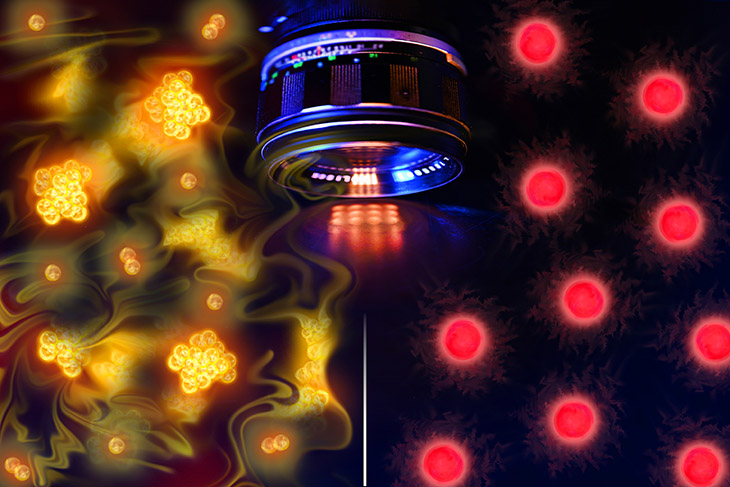

A Groundbreaking Glimpse into Quantum Interactions
In a historic scientific achievement, physicists at the Massachusetts Institute of Technology (MIT) have captured the first-ever images of individual atoms freely interacting in space. This breakthrough offers a visual confirmation of quantum mechanical behaviors that, until now, had only been theorized or indirectly inferred through complex calculations and models. With these unprecedented images, the MIT team opens a powerful window into the once-invisible world of quantum interactions, paving the way for a deeper understanding of quantum phenomena in real space.
“These are not just abstract mathematical predictions anymore — we can now see the quantum world at work with our own eyes,” said Martin Zwierlein, a physics professor at MIT, reflecting on the significance of the discovery.
Why Atoms Are So Hard to See
Atoms are notoriously difficult to observe individually, especially when in motion. A single atom measures roughly one-tenth of a nanometer — about a millionth the thickness of a human hair — and behaves according to the principles of quantum mechanics. This means that atoms do not behave like tiny billiard balls; instead, their position and momentum cannot be precisely determined at the same time, a phenomenon known as the Heisenberg uncertainty principle.
Until now, most imaging techniques could only capture the collective behavior or shape of an atomic cloud, similar to looking at a cloud in the sky without seeing the individual water droplets. Scientists have long known the underlying theory that governs atomic interactions, but visualizing these interactions in real time has remained elusive.
The Breakthrough: Atom-Resolved Microscopy
The MIT team developed a cutting-edge imaging method called “atom-resolved microscopy,” which allowed them to finally break through this observational barrier. The technique involves loosely trapping a cloud of atoms with a laser beam, letting them move and interact freely, and then momentarily freezing their motion with a lattice of light. This “freeze-frame” effect enables the researchers to take snapshots of the atoms’ positions using finely tuned lasers that illuminate the suspended particles just before they naturally disperse.
“It’s the first time we can do it in-situ — we can suddenly freeze the motion of the atoms when they’re strongly interacting and see them one after the other,” Zwierlein explained to MIT News. “That’s what makes this technique more powerful than anything that was done before.”
Capturing Bosons: Quantum Waves Come to Life
One of the key applications of the new imaging technique was studying bosons, particles that can occupy the same quantum state. Sodium atoms, which behave as bosons, were cooled to low temperatures to form a Bose-Einstein condensate, a special state of matter where all the particles share a single quantum wave.
Wolfgang Ketterle, a member of the MIT physics team and a Nobel laureate, was one of the first scientists to create a Bose-Einstein condensate in sodium atoms in the late 1990s. Now, Zwierlein’s group has gone a step further by capturing individual sodium atoms inside this condensate.
“It has long been predicted that bosons should ‘bunch’ together because they can share the same quantum mechanical wave,” Zwierlein noted. This bunching behavior — a direct manifestation of their quantum wave-like nature — was first theorized by Louis de Broglie, whose groundbreaking work laid the foundation for modern quantum mechanics.
“We understand so much more about the world from this wave-like nature,” Zwierlein said. “But it’s really tough to observe these quantum, wave-like effects. However, in our new microscope, we can visualize this wave directly.”
Unveiling Fermion Pairing: The Birth of Superconductivity
Beyond bosons, the team also examined fermions — particles that, unlike bosons, cannot occupy the same quantum state and typically repel each other. Electrons are a classic example of fermions, and their pairing under specific conditions leads to superconductivity, a phenomenon where electrical resistance drops to zero.
To observe fermionic interactions, the researchers cooled two different types of lithium atoms, each acting as a fermion. Remarkably, they observed these atoms pairing up, a critical process that underlies many exotic quantum phases, including superconductivity.
“This kind of pairing is the basis of a mathematical construction people came up with,” explained Richard Fletcher, an MIT assistant professor of physics and co-author of the study. “But when you see pictures like these, it’s an object that was discovered in the mathematical world. So it’s a very nice reminder that physics is about physical things. It’s real.”
The Road Ahead: Exploring Bizarre Quantum States
Looking to the future, the MIT team plans to apply their novel imaging approach to investigate even more exotic quantum phenomena, such as quantum Hall effects — scenarios where electrons in a magnetic field display highly correlated, collective behaviors.
“That’s where theory gets really hairy — where people start drawing pictures instead of being able to write down a full-fledged theory because they can’t fully solve it,” Zwierlein remarked. “Now we can verify whether these cartoons of quantum Hall states are actually real. Because they are pretty bizarre states.”
The ability to visualize these complex states could lead to transformative discoveries in quantum materials, potentially impacting the development of advanced quantum computers, superconductors, and other cutting-edge technologies.
A New Era in Quantum Visualization
This achievement marks a significant leap forward in experimental physics, providing tools that bridge the gap between abstract quantum theory and tangible observation. With their new imaging technology, MIT physicists have not only confirmed long-held theoretical predictions but also opened the door to uncovering new, uncharted quantum phenomena.
As Zwierlein and his colleagues continue to push the boundaries of what we can see and understand at the quantum level, the physics community and the world at large can look forward to a wave of discoveries that will reshape our grasp of nature’s most fundamental behaviors.
“This is just the beginning,” Zwierlein said. “There’s an entire universe of quantum interactions out there, waiting to be seen.”
What are your thoughts? Please comment below and share this news!
True Activist / Report a typo







